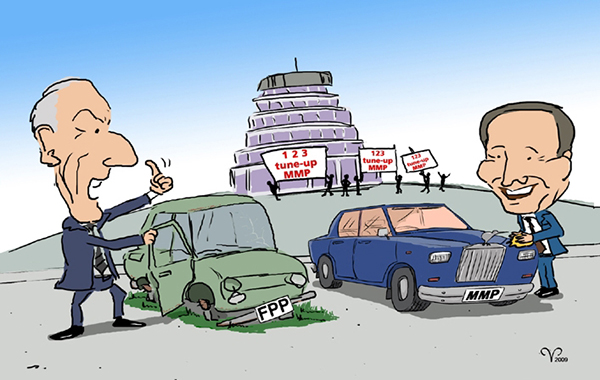Aotearoa has mixed-member proportional half right

Mahurangi Motors: ‘Yeah, no, John, the ’96 model came out with good ol’ vote-guzzling fptp carbie—you won’t believe the economy when we kit her out to mmpp. cartoon Majorlook Productions
Only half know what they are doing. That’s in general elections, where the turnout puts local government elections to shame—in spite of voters needing to travel no further than the mailbox.
And not only do a mere 52%post the 2003 election understand ‘which of the two votes that you have in mmp is more important’, the 79% turn-out means that only about 40% vote and know what they are doing. Scots, although not asked an identical question, have an even lower of knowledge of how their mixed-member proportional system works. A mere 24% knew the correct answer to the question:
…list seats are allocated to try to make sure each party has as fair a share of seats as is possible.
But before concluding that voter education is a lost cause and changing to a lesser system, or back to first-past-the-post, a simple tune-up the current system can be performed.
The tune-up is as easy as 1 2 3:
- Voters put a 1, or a tick, in the party box
- Voters, if so inclined, give their second preference a 2
- Voters, if so inclined, give their third preference a 3, and so on.
Repeat, for the electorate vote.
And that’s pretty much all there is to it:
- No need for three-yearly voter education
- Fewer list seats are needed
- Votes for also-ran parties and candidates are not wasted.
It achieves all this without reducing proportionality, which is mixed-member’s strong suit. Other proportional systems cannot match it and maintain small, single representative electorates—large electorates might be fine in cities but would be grotesquely large, geographically, in areas of sparse population.

Unsafe at Any Speed: ‘Shucks Shirty, that thing hasn’t had a warrant since 1996—there’s a limit to what even I can palm that off to my adorning and gullible public. At least it’s got to look as though it’s an improvement.’ cartoon Majorlook Productions/Mahurangi Magazine
Mixed-member proportional was launched on a 40-year groundswell of frustration with the crude and unjust first-past-the-post system, which for example in 1981 saw the Labour Party win 4122 more votes but National awarded four more seats, and Social Credit win 20.65% of votes but awarded only 2.17% of the seats. Its introduction succeeded in spite of Peter Shirtcliffe’s extravagantly orchestrated backlash. His current assault, however, could capitalise on the indignation caused by politicians, such as Winston Peters and Peter Dunne, who have shamelessly brought the system into disrepute.
After running sweetly for 13 years, notwithstanding the occasional intoxicated driver, this Rolls-Royce of proportional systems deserves a professional tune-up before being parked up—at least the Skyhawks were theoretically saleable.
Aotearoa’s hard-won proportional system is considerably more than half right, and runs far better than its vote-guzzling processor ever did, or could.
1 2 3, tune-up mmp!
How it works It is no more necessary to understand the intricacies of preferential voting, and the mechanics of how it can tune-up the proportional system, than it is for the cosseted passengers of the Rolls-Royce Ghost to know how its dual integrated chassis management systems work. However, STV and the Horrors of How provides a once-over-lightly explanation of preference voting.
